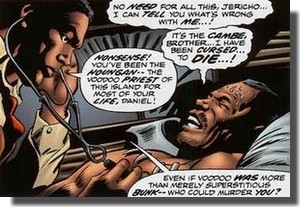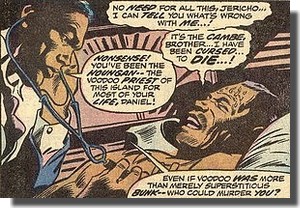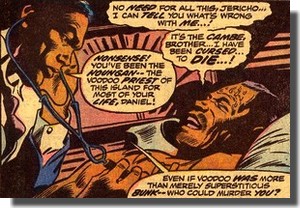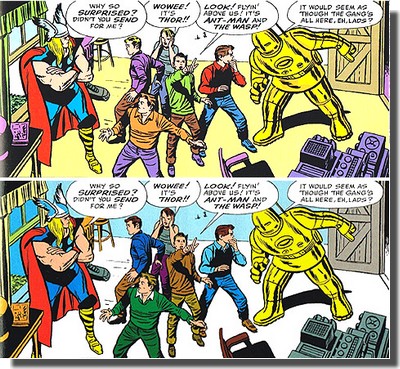MARVEL'S TRUE 1970s COLOURS
|
| MARVEL - HONOURING THE ROOTS | |||
| Ever since
the Marvel Age of Comics began and the Marvel Method held
sway, the House of Ideas has had an established tradition
of honouring its roots and making those first appearances
and adventures of their characters widely available
through reprints and collected editions. It all began in the summer of 1964 - a mere 30 months after the new era of Marvel Comics had exploded onto comic book stands - when Marvel published Marvel Tales Annual #1 as a 72-page reprint anthology featuring the first appearances of Spider-Man (from Amazing Fantasy #15, August 1962), the Hulk (The Incredible Hulk #1, May 1962), Ant-Man (Tales to Astonish #27, September 1962), Giant-Man (Tales to Astonish #49, November 1963), Sgt. Fury (Sgt. Fury and his Howling Commandos #1, May 1963), Iron Man (Tales of Suspense #39, March 1963) and his gold/red armour (Tales of Suspense #48, December 1963) as well as Thor (Journey into Mystery #83, August 1962). Also included was a two-page photo gallery of many of the staff and freelancers, including Stan Lee, Don Heck, Jack Kirby, Sam Rosen, Artie Simek, Flo Steinberg, Vince Colletta and many others. |
|||
|
| As early as
1964 Marvel did not restrict its reprints of earlier
material to these annual anthology titles and, for
example, ran The Fantastic Four #5 in Fantastic
Four Annual #2. Critics will no doubt see this as
simply squeezing the last cent from previously published
material almost a soon as the print had dried, and whilst
this certainly was an easy way for Marvel to generate
extra income (not the least because the House of Ideas
was at the time still restricted in terms of the number
of monthly titles its distributor - Independent, which in
contrast to its name was controlled by DC - was willing
to carry), it was most certainly also providing readers
with access to earlier material in an easy way. It is therefore no surprise that Marvel was also the first to venture into bookstores with Stan Lee's 1974 Origin of Marvel Comics, which reworked the concept of Marvel Tales Annual and Marvel Collectors' Item Classics into a hardcover and paperback book. Hugely successful, this was followed by such classics as Son of Origins of Marvel Comics (1975) and Bring on the Bad Guys - Origins of Marvel Villains (1976). |
| Given all of this background,
Marvel's publication of an anthology collection entitled Marvel
Firsts - The 1960s in October 2011 could hardly have
raised that many eyebrows, even though the same
publication formula from, let's say DC, would stop the
fan press everywhere and cause a sensation. With Marvel,
everybody knows they're exceptionally good at this part
of the game, so why bother with yet another 1960s reprint
collection, right? Wrong, utterly wrong. Now of course it's true that this compilation features many classic origin stories which most serious collectors will already call their own at least once in some format (personally, I believe I actually have no less than four reprint versions of Tales of Suspense #39 scattered throughout my collection, plus a digital version on my iPad), but this compilation actually is different from anything that's been put out before. In this case, the magic word is chronological order. The concept of "Firsts" is therefore to present stories from a publishing history's perspective and not, as is usually the case, from a character's point of view. Presented this way, even the best known Marvel stories from the 1960s take on a completely different tone, and readers can make their way through 488 pages and not only study the evolution of Atlas Comics into Marvel Comics but actually see the scale and complexity of the Marvel Universe unfolding and watch the rapidly changing sophistication in story and artwork. |
|
| The formula
employed for Marvel Firsts The 1960s is
therefore aimed at collecting the first issue of every
new title that Marvel launched in the 1960s, as opposed
to collecting first appearances of characters, although
there are a few fuzzy exceptions such as historically
important tryout shots (e.g. Spider-Man in Amazing
Fantasy #15). Marvel's logic for that specific
example is that it's where Spidey's ongoing solo stories
kicked off - and we won't argue with that. Other criteria
for selecting the material (according to Marvel) were
that the series has to be set in the Marvel Universe,
that it had to star a character who had never had an
ongoing series before, and that any one-shot story needed
to be relatively close to the debut of its connected
ongoing series. The journey thus takes readers all through the 1960s from Rawhide Kid #17 (August 1960) right up to Silver Surfer #1 (August 1968), but as even a book of almost 500 pages has its limitations for the first decade of the ever expanding Marvle Universe, a selective choice had to be made, ultimately creating inevitable gaps. However, Marvel opted for a smart remedy to this by including pages with four covers each of titles which do not feature as story reprints but nevertheless formed a part of the evolving production of Marvel Comics in the 1960s and featured noteworthy points such as the debut of a new series, the retitling of an ongoing series, or a new character's strip making its debut in an ongoing series (such as the Hulk in Tales to Astonish #70). Again, these pages are interspersed in line with the chronological order, and the book kicks off with a 4-page rundown of all the Atlas books that were published in January/February 1960. And all that for $29.99? That's excellent value for money, and again Marvel has come up with a reprint formula that works wonders. But possibly the best thing about Marvel Firsts The 1960s is that it doesn't stop there... |
|||
| SAVOURING THE SEVENTIES | |||
| The 1960's Silver Age period of Marvel Comics is fairly well covered with extensive collected reprint editions in the Marvel Omnibus and Masterworks imprints. Although the latter is by now reaching the early 1970s for some characters (most noticeably Spider-Man, FF, Avengers, Thor, Captain America and Iron Man) it will still be a while until the peak of the Bronze Age will be available in these collected formats. Marvel Essentials have, of course, filled that gap so far, although the black & white reprints are not everybody's taste and only provide mere fillers for want of a better solution for many collectors (including your reviewer). Now, finally, Marvel provides the possibility to savour the 1970s in all of their primary colour glory - with no less than three volumes of Marvel Firsts The 1970s. | |||
|
|||
|
|||
|
|||
| Volume 2
picks up in July 1973 with Tales of the Zombie
#1 and brings the story right up to May 1975 with Giant-Size
X-Men #1. En route, readers encounter Morbius the
Living Vampire (from Vampire Tales #1), Satana (Vampire
Tales #2), the Living Mummy (Supernatural
Thrillers #5), Brother Voodoo (Strange Tales
#169), the Golem (Strange Tales #174), the Thing
(Marvel Feature #11), Son of Satan (Marvel
Spotlight #12), It! (Astonishing Tales
#21), Deathlok (Astonishing Tales #25), Sons of
the Tiger (Deadly Hands of Kung Fu #1), Iron
Fist (Marvel Premiere #15), Man-Thing (Creatures
on the Loose #30), Gabriel Devil Hunter (Haunt
of Horror #2), John Kowalski (War is Hell
#9), Tigra (Monsters Unleashed #10), Howard the
Duck (Giant-Size Man-Thing #4), and the Invaders
(Giant-Size Invaders #1). The 1973-1975 was an especially interesting period at Marvel as this list instantly shows, and the work collected in Volume 2 of Marvel Firsts The 1970s is bound to hold some real discoveries for most readers. The importance of horror and Marvel's very own approach in creating "superheroes from the crypt" comes across nicely, as does the period's martial arts exploitation, although sadly enough the most important character from this genre part of the Marvel Universe - Shang Chi - does not feature. Originally introduced as the son of Fu Manchu, Marvel has since lost the rights to Sax Rohmer's creation, rendering a reprint of Special Marvel Edition #15 (December 1973) impossible. Volume 3 will complete the trip through the 1970s by featuring material from August 1975 (Skull ther Slayer #1) right up to February 1980 (Savage She-Hulk #1 - which by the way and according to the Marvel Bullpen Bulletin of the time was Stan Lee's first new comic book creation since 1972). In between, there's the Champions, Black Goliath, Omega the Unknown, the Eternals, Nova, Ms Marvel, Devil Dinosaur and Machine Man alongside titles such as Marvel Preview and What If? |
|||
| All in all,
Marvel Firsts The 1970s is another collected
edition winner from Marvel. For those unfamiliar with the
1970s these three volumes will provide an (almost)
one-stop opportunity to get a broad idea of what the
1970s Marvel Bronze Age was like, and for those who
experienced parts of this period (or even all of it)
themselves as comic book readers it will be a most
pleasant stroll down memory lane, sugarcoated with
numerous discoveries along the way. Reading the material
in consecutive order also provides a fascinating insight
into the varied new developments at the House of Ideas as
the 1970s progressed. This also in some way accentuates
the fact that whilst these comic books were in many ways
still essentially done-in-ones (i.e. a story contained
within one issue) they nevertheless always left you
dangling somewhere in one form or another of a
cliffhanger - and just as you do not get to read the next
issue within these collected editions, that was also
often true in the 1970s when an uninterrupted supply of
titles to wherever you bought them from was never
guaranteed. As such, Marvel Firsts The 1970s is
a true time capsule. Some may lament the fact that these collected editions are published in paperback version only, but this not only keeps down the price (ensuring that more readers will pick them up) but is also in tone with the contents - the paperback format is at least slightly reminiscent of the original "floppy" format, although thankfully readers are spared the sometimes truly dismal period quality of paper and consequently printing. Speaking of which - the visual rendition is another strong point in terms of Marvel's editorial treatment of Marvel Firsts. |
|||
| TRUE COLOURS SHINING | |||
|
|||
| Quintessentially a matter of taste, a collection such as Marvel Firsts The 1970s does nevertheless command some editorial caution in terms of boosting the material's appearance, and Marvel has taken a very sensible approach in order to create an overall impression of authenticity. | |||
   |
|||
| Now of
course anyone with a certain depth of knowledge of comic
book history will know that the colouring in comic books
was always subject to a certain degree of volatility. This example panel from Avengers #1 (with the top image showing the original colouring and the bottom depicting the colours used for the Marvel Masterworks version) illustrates this nicely and at the same time shows just what an influence the colouring does have on the final overall appearance. Bearing that in mind, a few introductory notes on the approach to comic book colouring and the technology employed in the 1970s would have been quite nice and could have looked something like this... |
|||
 |
DIGRESSION - THE CMYK
PRINTING PROCESS The typical 1970s comic book look of limited colours displaying a rather washed-out appearance with reduced contrast separation was due to two main factors: the so-called "Subtractive Primaries Colour Printing" or "Four Colour Process" (CMYK for short), and the fact that more often than not the paper used for printing comics was of inferior quality; known as newsprint, it was used primarily for its low cost factor and its high absorbency, which was well suited to rubber plates used on high-speed offset presses. The production process of newsprint paper results in very short fibres and high levels of lignin, which rapidly discolour and oxidise - in other words: the paper used for comic books was hardly ever actually white. The problem with this was - subtractive colour printing works best when the paper is white... |
| The CMYK printing process produces the necessary varying colors by applying the so-called subtractive primaries Cyan (blue), Magenta (purple) and Yellow. |
| Mixing yellow
and cyan produces green colours, whilst yellow mixed with
magenta results in reds and magenta with cyan in blues.
Mixing equal amounts of cyan, magenta and yellow in
sufficient density produces black, but in order to save
ink and decrease drying times black is used as the fourth
colour pigment for the so-called "key" (hence
the letter K) printing plate, which
prints the artistic detail of an image (Ferry, 1921). A four-colour printing press therefore uses four printing plates - one for each colour separation - wrapped around a cylinder and inked with the relevant colour. As paper passes through the press, the cyan, magenta, yellow and black separations are printed one on top of the other. This can produce a wide range of colours by combining different tints of the four inks as colours are split into so-called "component separations". |
|
| In applying this system, a full red colour can be described as being the result of 0% cyan, 100% magenta, 100% yellow and 0% black, whereas a medium blue separates as 100% cyan, 50% magenta, 0% yellow and 0% black. In the case of a photographic image, each pixel can be separated into percentages of the four CMYK components, but the separations used for comic books up until the 1980s were much cruder (using only tones of 0%, 25%, 50%, 75% and 100%), leaving colourists with a greatly reduced selection of colours available. The printed result was further hampered by the very course dot grid which in some cases was noticeable not only in close-up as "dotty printing" and which produces the classic Silver and Bronze Age "colour dots". The basic 64 colours which could be produced from this system are shown in a chart guide from the Chemical Color Plate Corporation in Bridgeport, which did colour separations for both Marvel and DC. | |||
|
|||
| THE WRAP-UP | |||
| It is quite
obvious that a substantial amount of planning and
editorial care has gone into the production of Marvel
Firsts The 1970s, and the result is another
collected edition winner from Marvel. The selection of
material reprinted in these three volumes is an excellent
introduction to Bronze Age Marvel for first time readers
whilst at the same time satisfying the nostalgia of those
who were around to pick up some of those titles as they
first appeared on newsstands and spinner racks. For
collectors, the three volumes fill an important gap, and
for those interested in the history of comic books and,
specifically, the development of Marvel Comics, the
underlying organisational logic and ordering principle
applied to Marvel Firsts The 1970s provides
loads of insight and must be the next best thing to
actual time travel. In other words - and as they used to tell you back in the 1970s - go get it, effendi! |
|||
| This is a bona fide review of a publication from Marvel Comics. The reviewer has no professional or personal connection to the publishing company or any of the individuals involved in the publication process and does not profit from this review in any direct or indirect way. | |||
| BIBLIOGRAPHY FERRY Ervin Sidney (1921) General Physics and Its Application to Industry and Everyday Life, John Wiley & Sons |
|||
|